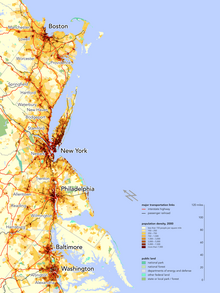BosWash
This article is missing information about to what degree these predictions did or did not come true. (December 2023) |

BosWash is a name coined by futurist Herman Kahn in a 1967 essay describing a theoretical United States megalopolis extending from the metropolitan area of Boston to that of Washington, D.C.[1] The publication coined terms like BosWash, referring to predicted accretions of the Northeast, and SanSan (San Francisco to San Diego) for the urbanized region in Coastal California. The general concept for the area described by BosWash was first identified (with the name "Megalopolis") as "The Atlantic seaboard area from north of Boston to south of Washington" by French geographer Jean Gottmann in the annual report of the Twentieth Century Fund on May 25, 1958.[2] Gottman elaborated on the 600 miles (970 km) stretch of cities in his 1961 book Megalopolis: The Urbanized Northeastern Seaboard of the United States, although the term BosWash did not appear in the work.[3]
BosNYWash is a variant term that specifically references New York City,[4] which is a central hub and has long been by far the largest metropolis in the region and the country. In 1971, The Bosnywash Megalopolis was published.[5]
Origin
[edit]
The publication of the ideas of Kahn and Wiener were part of a study commissioned in 1965 by the American Academy of Arts and Sciences, which published the results of the commission's findings in the summer of 1967 as "Toward the Year 2000: Work in Progress", a special issue of Dædalus, journal of the academy.[6] In their portion of the work, Kahn and Wiener, discussing urbanization, began by writing the following.[7]
The United States in the year 2000 will probably see at least three gargantuan megalopolises. We have labeled these—only half frivolously—"Boswash," "Chipitts," and "SanSan."
The pair went on to give rough geographic dimensions to the areas. BosWash was described as "the megalopolis that will extend from Washington to Boston" along "an extremely narrow strip of the North Atlantic coast."[7] ChiPitts, mentioned as being from Chicago to Pittsburgh but extending east to Rochester, New York, was laid out as "on Lake Erie and the southern and western shores of Lake Michigan and Lake Ontario" and SanSan as "an even more narrow strip on the West Coast" from either Santa Barbara or San Francisco to San Diego in California.[7]
Usage
[edit]The three terms gained use in the period immediately following publication of The Year 2000, with Newsweek using them in 1967[8] and Changing Times featuring them in 1968.[9] However, the names are currently not used in any official capacity, and, of the three, only BosWash is defined in Random House Dictionary, described there as informal.[10]
Isaac Asimov predicted in 1964 that by 2014, "Boston-to-Washington, the most crowded area of its size on the earth, will have become a single city with a population of over 40,000,000".[11]
Virginia Tech's Metropolitan Institute outlined an area it labeled the "Northeast" megapolitan area, which it views as extending beyond Boston and Washington – past Portland, Maine and Richmond, Virginia – and described it as one of ten such areas in the United States.[12] In the 2005 study, titled Beyond Megalopolis, researchers analyzed Google search results to determine plausible names for the regions, rejecting terms such as BosWash, stating: "We decided that combined place names seemed contrived and offered little chance for eventual adoption. Therefore, labels such as 'BosWash' to refer to the Northeast or 'SanSac' in reference to the combined San Francisco and Sacramento metropolitan areas were not considered."[12]
See also
[edit]- East Coast of the United States
- Eastern United States
- Megacity
- Northeast Corridor
- Northeastern United States
- Northeast megalopolis
- Unofficial U.S. multi-state regions
References
[edit]- ^ The term BosWash first appeared in a 1967 publication of predictions for the future by the Hudson Institute: Kahn, Herman & Weiner, Anthony (1967). The Year 2000: A Framework for Speculation on the Next Thirty-Three Years. New York: Macmillan. p. 61. ISBN 978-0-02-560440-7.
- ^ "City Chain in East Forming a System— Paris Analyst Calls Coastal 'Megalopolis' the World's 'Largest, Most Complex'", The New York Times, May 26, 1958, p. 32
- ^ Gottmann, Jean (1961). Megalopolis: the Urbanized Northeastern Seaboard of the United States. M.I.T. Press. ISBN 0-527-02819-3.
- ^ Jones, Richard C. (1982). Immigrants outside megalopolis: ethnic transformation in the heartland. Lexington Books. p. 3. ISBN 978-0-7391-1919-8.
- ^ Swatridge, L. A. (1971). The Bosnywash Megalopolis. McGraw-Hill. ISBN 0-07-092795-2.
- ^ Commission On The Year 2000, American Academy of Arts Sciences (1997). Book overview: Toward the year 2000: work in progress. By Daniel Bell, Stephen Richards Graubard. MIT Press. ISBN 9780262522373. Retrieved 2009-10-24.
{{cite book}}: CS1 maint: numeric names: authors list (link) - ^ a b c Bell, Daniel; et al. (Summer 1967). "Toward the year 2000: work in progress". Dædalus. 96 (3). Cambridge, MA: American Academy of Arts and Sciences: 718–719. ISBN 9780262522373. OCLC 36739595. Retrieved 2009-10-24.
- ^ McCamy, James Lucian (2002-01-15). The Quality of the Environment. Simon and Schuster. p. 42. ISBN 0-7432-3633-5. Retrieved 2009-10-20.
- ^ "The Good Life, 1970's Style". Changing Times. 22 (1). Washington, D.C.: Kiplinger Washington Editors, Inc. January 1968. ISSN 1528-9729. Retrieved 2009-10-20.
- ^ "Boswash Definition". Random House Dictionary. 2009. Retrieved 2009-10-20.
- ^ Asimov, Isaac (2016-08-16). "Visit to the World's Fair of 2014". The New York Times. Retrieved 2016-11-03.
- ^ a b Lang, Robert E. & Dhavale, Dawn (July 2005). "Beyond Megalopolis: Exploring America's New "Megapolitan" Geography" (PDF). Census Report Series. 05 (1). Blacksburg, Virginia: Metropolitan Institute at Virginia Tech. Archived from the original (PDF) on 2009-03-27.
